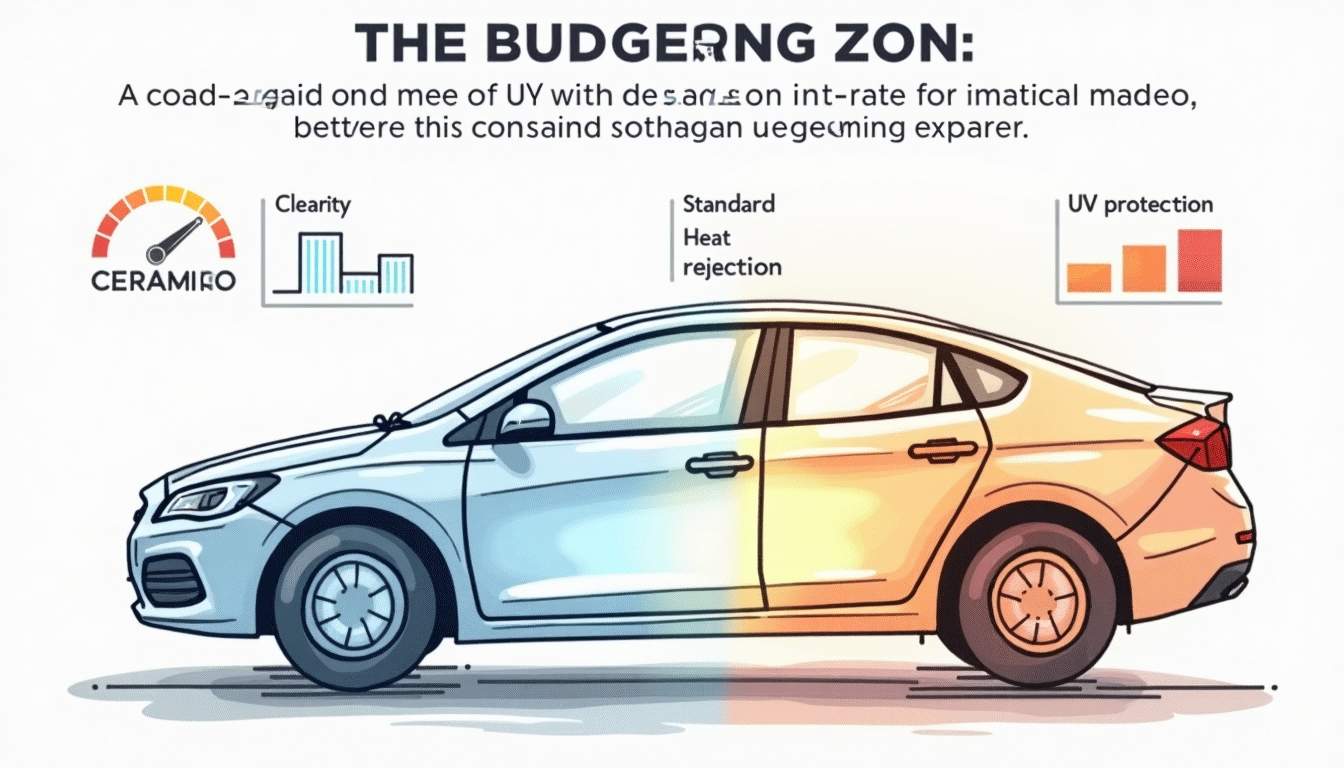views
Gone are the days when tinting was simply about adding a dark shade to your windows. Today, advanced materials and technologies have transformed window films into sophisticated products that not only enhance aesthetics but also improve comfort, safety, and energy efficiency. Among the most popular options are ceramic tints, with two main contenders dominating the market: standard ceramic tinting and the newer nano-ceramic tinting.
This article delves deep into the differences between nano-ceramic and standard ceramic tinting, exploring their unique properties, benefits, and potential drawbacks. Whether you’re considering tinting your vehicle or upgrading your home or office windows, understanding these cutting-edge films will help you make an informed decision.
Understanding Ceramic Tinting: The Basics
Ceramic tinting has gained widespread popularity due to its superior performance compared to traditional dyed or metallic tints. Unlike older films that rely on dyes or metals, ceramic tints use ceramic particles embedded within the film to block heat and UV rays.
Standard ceramic tints typically contain microscopic ceramic particles that are non-metallic and non-conductive. This composition allows them to block a significant amount of infrared heat and ultraviolet radiation without interfering with electronic signals such as GPS, radio, and cell phone reception. The result is a tint that keeps interiors cooler and protects occupants from harmful UV rays while maintaining clear visibility.
In addition to heat rejection, ceramic tints offer excellent durability and resistance to fading and discoloration over time. They also tend to have a more neutral appearance, avoiding the overly dark or reflective look that some metallic films produce. This makes them an ideal choice for those who want to enhance their vehicle's aesthetics without compromising on functionality. Furthermore, the clarity and transparency of ceramic films allow for a more natural light transmission, ensuring that drivers and passengers can enjoy a bright and airy cabin space. For more details on professional ceramic tint installation, visit OC Tint Solutions.
Another noteworthy aspect of ceramic tinting is its ability to enhance privacy without sacrificing visibility. The subtle shading provided by ceramic films can deter prying eyes while still allowing the driver to see clearly out of the windows. This balance of privacy and visibility is especially appealing for families or individuals who frequently travel with valuables in their vehicles. Additionally, many ceramic tints come with a manufacturer's warranty, providing peace of mind regarding their longevity and performance. This assurance further solidifies ceramic tinting as a wise investment for vehicle owners looking to improve both comfort and protection.
Key Benefits of Standard Ceramic Tinting
- Heat Rejection: Blocks up to 50-60% of infrared heat, reducing interior temperatures.
- UV Protection: Blocks up to 99% of harmful UV rays, protecting skin and interior materials.
- Signal Friendly: Non-metallic composition ensures no interference with electronic signals.
- Durability: Resistant to fading, bubbling, and discoloration over time.
- Appearance: Offers a sleek, non-reflective finish that complements vehicle aesthetics.
Introducing Nano-Ceramic Tinting: The Next Generation
Building on the success of standard ceramic films, nano-ceramic tinting represents the latest innovation in window film technology. Nano-ceramic films incorporate nanoparticles—ultra-fine ceramic particles measured on the nanometer scale—that provide enhanced performance characteristics.

These nanoparticles are significantly smaller than the ceramic particles used in standard films, allowing for a more uniform distribution within the film. This advanced structure results in superior heat rejection, improved clarity, and even greater durability. Nano-ceramic films are engineered to maximize the benefits of ceramic technology while minimizing any potential downsides.
What Sets Nano-Ceramic Tinting Apart?
One of the standout features of nano-ceramic tinting is its exceptional ability to block infrared heat. While standard ceramic films block a substantial portion of heat, nano-ceramic films can reject up to 70% or more of infrared radiation, significantly enhancing cabin comfort.
Moreover, nano-ceramic films maintain high visible light transmission, which means they reduce heat without making windows excessively dark. This balance is particularly appealing for those who want to preserve visibility and comply with legal tint limits.
Another advantage is the film’s clarity and color stability. Nano-ceramic films tend to have a more neutral tint with less color distortion, preserving the natural look of the glass and the view outside. This is especially beneficial for car enthusiasts who want to showcase their vehicle's interior and exterior aesthetics without compromising on performance.
Additional Advantages of Nano-Ceramic Films
- Superior Heat Rejection: Blocks more infrared heat than standard ceramic films.
- High Clarity: Maintains excellent visibility with minimal color distortion.
- UV Protection: Offers near-complete UV ray blockage, protecting skin and interiors.
- Signal Compatibility: Non-metallic and non-conductive, ensuring no signal interference.
- Durability: Enhanced resistance to scratches, fading, and discoloration.
- Glare Reduction: Improves driving comfort by reducing glare from the sun and headlights.
In addition to these impressive features, nano-ceramic tinting is also environmentally friendly. The manufacturing process of these films typically involves fewer harmful chemicals compared to traditional options, making them a safer choice for both consumers and the planet. Furthermore, by reducing the need for air conditioning due to improved heat rejection, nano-ceramic films can contribute to lower energy consumption in vehicles, promoting sustainability in everyday driving.
Another noteworthy aspect of nano-ceramic tinting is its versatility. Suitable for a wide range of applications, from residential windows to commercial buildings and automotive uses, these films can be tailored to meet specific needs and preferences. Whether you’re looking to enhance privacy, improve energy efficiency, or simply elevate the appearance of your property, nano-ceramic films offer a comprehensive solution that caters to diverse requirements while delivering cutting-edge technology.
Performance Comparison: Nano-Ceramic vs Standard Ceramic
When deciding between nano-ceramic and standard ceramic tinting, it’s important to evaluate their performance across several key factors: heat rejection, UV protection, visibility, durability, and cost.

Heat Rejection
Both standard and nano-ceramic films excel at blocking heat compared to traditional tints. However, nano-ceramic films typically outperform standard ceramic films by a noticeable margin. By blocking more infrared radiation, nano-ceramic films keep vehicle interiors cooler, reduce reliance on air conditioning, and improve overall comfort, especially in hot climates.
UV Protection
UV protection is critical for preventing skin damage and protecting the vehicle’s interior from fading and cracking. Both types of ceramic films block up to 99% of UV rays, making them highly effective in this regard. There is little difference between the two when it comes to UV protection.
Visibility and Appearance
Standard ceramic films offer a sleek, non-reflective finish that enhances the look of a vehicle without excessive darkening. Nano-ceramic films take this a step further by providing superior clarity and a more neutral tint. This means less color distortion and better visibility, which is especially important for drivers who want to maintain clear sightlines while still enjoying the benefits of tinting.
Durability and Longevity
Both films are highly durable and resistant to fading, bubbling, and discoloration. However, the advanced nanoparticle technology in nano-ceramic films enhances scratch resistance and maintains the film’s appearance longer than standard ceramic films. This makes nano-ceramic a better long-term investment for those seeking maximum durability.
Cost Considerations
One of the main differences between the two films is cost. Nano-ceramic tinting is generally more expensive due to its advanced technology and superior performance. Standard ceramic films offer excellent value for those on a budget, while nano-ceramic films are ideal for customers willing to invest more for cutting-edge benefits.
Applications Beyond Automotive Tinting
While much of the discussion around ceramic and nano-ceramic films centers on automotive use, these technologies are increasingly popular for residential and commercial buildings as well. Window films can improve energy efficiency, reduce glare, and protect interiors in a variety of settings.

Residential Window Tinting
Homeowners are turning to ceramic and nano-ceramic films to reduce cooling costs, block UV rays, and enhance privacy without sacrificing natural light. Nano-ceramic films are particularly appealing for homes with large glass windows or sunrooms, where heat buildup can be problematic.
Commercial and Office Buildings
In commercial settings, window films contribute to energy savings by reducing the load on HVAC systems. They also create more comfortable work environments by minimizing glare on computer screens and protecting furnishings from sun damage. Nano-ceramic films, with their superior heat rejection and clarity, are often preferred for high-end office buildings and retail spaces.
Installation and Maintenance Tips
Regardless of whether you choose standard or nano-ceramic tinting, professional installation is crucial for optimal performance and longevity. Skilled technicians ensure the film is applied smoothly without bubbles, creases, or dust particles trapped underneath.
Maintenance is relatively straightforward. Regular cleaning with a mild, non-abrasive cleaner and a soft cloth will keep the tint looking fresh. Avoid ammonia-based products, as they can degrade the adhesive and damage the film over time.
Final Thoughts
Both standard ceramic and nano-ceramic tinting offer significant advantages over traditional films, providing excellent heat rejection, UV protection, and durability without interfering with electronic signals. The choice ultimately depends on your priorities and budget.
If you’re looking for a high-performance film that offers the best heat rejection, clarity, and long-term durability, nano-ceramic tinting is the premium option worth considering. It’s especially beneficial in hot climates or for those who spend a lot of time driving or working near large windows.
On the other hand, standard ceramic tinting remains an excellent choice for those seeking a balance between performance and cost. It delivers many of the benefits of nano-ceramic films at a more accessible price point, making it a popular option for everyday drivers and homeowners alike.
Ultimately, investing in either type of ceramic film is a smart decision that enhances comfort, protects your investment, and elevates the look of your vehicle or property. With ongoing advancements in film technology, the future promises even more innovative solutions for window tinting.



Comments
0 comment